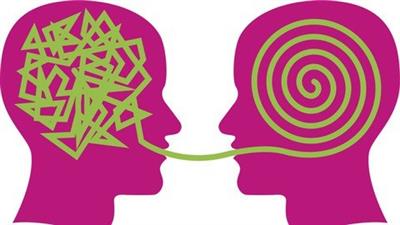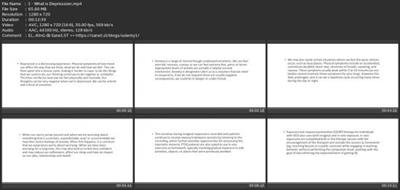M
0

Cognitive Therapy Course Certified And Diploma : Anxiety
Son güncelleme tarihi: 5/2022
MP4 | Video: h264, 1280x720 | Audio: AAC, 44.1 KHz
Language: Türkçe | Size: 638.09 MB | Duration: 2h 0m
CT- Cognitive Therapy Certified Programme I You will refer to the Contracted CPD institutions for certificate
Son güncelleme tarihi: 5/2022
MP4 | Video: h264, 1280x720 | Audio: AAC, 44.1 KHz
Language: Türkçe | Size: 638.09 MB | Duration: 2h 0m
CT- Cognitive Therapy Certified Programme I You will refer to the Contracted CPD institutions for certificate
What you'll learn
Anxiety Disorders
What is Depression?
Constructivist Therapy and Other Therapies
Principles of CT (Cognitive Disorders)
Cognitive and Behaviroul Techniques
Practical İnterventions
Psychoeducation
Exposures
Cognitive Behaviroul Therapy (CBT)
Psychological Intervention Method Comparison
Psychological Therapy Methods
Cognitive Therapy Methods
Cognitive Therapy Course
Cognitive Therapy Methods
Students will identify and define the critical elements of a cognitive-behavioral case formulation.
Using provided clinical cases, students will write a cognitive-behavioral case formulation using the elements of a case formulation.
Students will describe the basic strategies employed in practice for clinical monitoring.
Students will demonstrate provision of psychoeducation to intervention to their peers in a cognitive behavior group
Students will describe and demonstrate behavioral activation and pleasant event scheduling in a group or individual therapy format.
Students will demonstrate identification of automatic thoughts, assumptions, rules, and core beliefs in a group or individual therapy format.
Students will discuss and describe how to assign, assess, and problem-solve therapeutic homework.
Students will demonstrate how to implement thought monitoring, Socratic questioning, and adaptive thought identification in a group or individual therapy format
Students will demonstrate development of an exposure hierarchy and implementation of exposure intervention in a group or individual therapy format.
Requirements
No
Description
Cognitive therapy (CT) is a type of psychotherapy developed by American psychiatrist Aaron T. Beck. CT is one therapeutic approach within the larger group of cognitive behavioral therapies (CBT) and was first expounded by Beck in the 1960s. Cognitive therapy is based on the cognitive model, which states that thoughts, feelings and behavior are all connected, and that individuals can move toward overcoming difficulties and meeting their goals by identifying and changing unhelpful or inaccurate thinking, problematic behavior, and distressing emotional responses. This involves the individual working with the therapist to develop skills for testing and changing beliefs, identifying distorted thinking, relating to others in different ways, and changing behaviors.[1] A cognitive case conceptualization is developed by the cognitive therapist as a guide to understand the individual's internal reality, select appropriate interventions and identify areas of distress.Therapy may consist of testing the assumptions which one makes and looking for new information that could help shift the assumptions in a way that leads to different emotional or behavioral reactions. Change may begin by targeting thoughts (to change emotion and behavior), behavior (to change feelings and thoughts), or the individual's goals (by identifying thoughts, feelings or behavior that conflict with the goals). Beck initially focused on depression and developed a list of "errors" (cognitive distortion) in thinking that he proposed could maintain depression, including arbitrary inference, selective abstraction, over-generalization, and magnification (of negatives) and minimization (of positives).As an example of how CT might work: Having made a mistake at work, a man may believe: "I'm useless and can't do anything right at work." He may then focus on the mistake (which he takes as evidence that his belief is true), and his thoughts about being "useless" are likely to lead to negative emotion (frustration, sadness, hopelessness). Given these thoughts and feelings, he may then begin to avoid challenges at work, which is behavior that could provide even more evidence for him that his belief is true. As a result, any adaptive response and further constructive consequences become unlikely, and he may focus even more on any mistakes he may make, which serve to reinforce the original belief of being "useless." In therapy, this example could be identified as a self-fulfilling prophecy or "problem cycle," and the efforts of the therapist and patient would be directed at working together to explore and change this cycle.People who are working with a cognitive therapist often practice more flexible ways to think and respond, learning to ask themselves whether their thoughts are completely true, and whether those thoughts are helping them to meet their goals. Thoughts that do not meet this description may then be shifted to something more accurate or helpful, leading to more positive emotion, more desirable behavior, and movement toward the person's goals. Cognitive therapy takes a skill-building approach, where the therapist helps the person to learn and practice these skills independently, eventually "becoming their own therapist."
Overview
Section 1: İntroductıion to Depression and Cognitive Therapy
Lecture 1 What is Depression?
Lecture 2 Anxiety Disorders
Lecture 3 Constructivist Therapy and Other Therapies
Lecture 4 Principles of CT (Cognitive Therapy)
Lecture 5 Cognitive and Behaviroul Techniques
Section 2: İnterventions and Education for Cognitive Therapy
Lecture 6 Practical İnterventions
Lecture 7 Psychoeducation, Exposures
Lecture 8 Cognitive Behaviroul Therapy (CBT)
Lecture 9 Early Behaviour Therapy
Lecture 10 Imaginal exposure compared with in-vivo exposure and their combination
Lecture 11 Cognitive Therapy compared to in-vivo exposure with ritual prevention
Lecture 12 CBT skills that are developed
Section 3: Obtain Your Certificate of Achievement
Lecture 13 Obtain Your Certificate of Achievement
Section 4: FREE UNLIMITED CONTENT AND ACCESS OTHER FUN COURSES YOU CAN CERTIFICATE
Lecture 14 FREE UNLIMITED CONTENT AND ACCESS OTHER FUN COURSES YOU CAN CERTIFICATE
Psychologist,Clinic Psychologist,Clinic Centers,Therapy Centers,Students,Anyone who wants to improve themselves,Psychiatrist,Psychological Therapists,CT practitioners,CBT practitioners

Download link
rapidgator.net:
[lin
You must reply in thread to view hidden text.
[lin
You must reply in thread to view hidden text.
[lin
You must reply in thread to view hidden text.
[lin
You must reply in thread to view hidden text.

